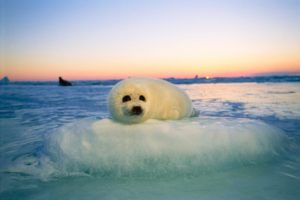Harp Seal – Threats to Their Homes
 Harp seals rarely set foot on land, but when they do come ashore, they board the Arctic ice pack. A thick layer of frozen water sitting atop the ocean, the ice pack undergoes a regular seasonal melt. The ice begins to melt in the spring and summer, with little left by mid-September. As autumn rolls back around, the ice starts to reform and doubles in cover for the winter. Not all ice melts, and some survives the warmer weather of the summers from year to year. Generally, sea ice consists of first-year ice, which is thin, and thicker ice that has accumulated in volume over time, called multi-year ice.
Harp seals rarely set foot on land, but when they do come ashore, they board the Arctic ice pack. A thick layer of frozen water sitting atop the ocean, the ice pack undergoes a regular seasonal melt. The ice begins to melt in the spring and summer, with little left by mid-September. As autumn rolls back around, the ice starts to reform and doubles in cover for the winter. Not all ice melts, and some survives the warmer weather of the summers from year to year. Generally, sea ice consists of first-year ice, which is thin, and thicker ice that has accumulated in volume over time, called multi-year ice.
There has been a trend, in recent decades, for a decline in the thicker multiyear ice, due to a warmer global climate. Harp seals rely heavily on this ice for much of their life cycle and it is a vital feature of their landscape. Ice that melts too readily puts pups at risk of falling into the sea too early, before they are able to swim. And with no mother around to protect them, the results can be fatal. It is not just the weakest pups, or those with lower genetic diversity that are in danger. During seasons of extremely low ice cover, entire generations may be wiped out due to the harp seals’ reliance on the ice as a platform for giving birth and rearing their young.
A reduction in ice could also have an impact on reproductive success through a loss of breeding ground, meaning fewer pups being born. However, much of this is speculation and the long-term effects are unknown. At present, the species is listed as ‘Least Concern’ by the IUCN and there are currently an estimated eight million harp seals in the Northern Hemisphere.
A coveted coat
A quick search on the Internet for ‘harp seals and humans’, will tell you everything you need to know about the relationship we have with these intelligent creatures. Sadly, almost every page is awash with stories of hunting and sealing. The main attraction for the hunting industry is the snowy white pelts of the harp seal pups, an attraction that has led to more than one million deaths in the past five years. The number of seals killed each year is usually forecasted and regulated through the use of quotas. However, it’s estimated that many catches go unreported.
The fur is generally used for coat making, while the meat is used as an important source of protein for the inhabitants of small coastal communities. The blubber is broken down and used to make seal oil, which is then used as a fish oil supplement. The skin is also used in the fashion industry and tailored to make warm garments for colder climes. The act of harp seal hunting has gathered much debate and attention among conservationists about the appropriate course of action to safeguard the species for the future.
















1 thought on “”
Ice lover is certainly a beautiful thing to look at.